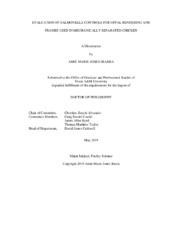| dc.description.abstract | .
This study was conducted to verify and continue to enhance the area of food safety within fresh and further processed poultry products. Objectives included: 1) determine the thermal inactivation of Salmonella enterica in poultry offal during rendering at differing temperatures; 2) evaluate the potential for development of systemic Salmonella infection in chickens as a function of challenge method and route to determine the possibility of systemic infections, and; 3) determine the effectiveness of a novel treatment of combined hydrogen peroxide (Hv2Ov2) and ultraviolet (UV) light with use of a Hydrogen Peroxide and UV – Advanced Oxidative Processing machine (H2O2/UV-AOP) to reduce aerobic bacteria and Salmonella in chicken frames.
Results from the rendering verification study showed mean D-values for the Salmonella cocktail at 150, 155, and 160 °F were 0.25 ± 0.05, 0.17 ± 0.01, and 0.09 ± 0.01 min, respectively, indicative of increasing susceptibility to increased application of heat during processing. Current poultry byproducts rendering procedures are effective for achieving necessary Salmonella control when completed under sanitary conditions.
Results from the systemic chicken infection study indicated some challenge method techniques resulted in Salmonella infection into bone marrow within six days of challenge, but cells were cleared by nine days post-challenge. Data show significant differences between gavage, tracheal, and H2)2transdermal scratch Salmonella challenge on breast muscle without feathers regarding the location of administered bacteria. Regardless of the route of administration, all challenged birds were positive for Salmonella by 6 days post-inoculation. Overall results indicate it is possible for a Salmonella infection to reach the bone marrow, signifying the needs for hygienic rearing of broilers until the point of meat harvest in order to prevent Salmonella transmission to carcass components potentially used in manufacture of non-intact poultry meat products. Results from the Hv2Ov2/UV-AOP application onto broiler frames for two applied concentrations of Hv2Ov2indicate similar reductions in Salmonella of 1.1 log10 CFU/frame at 5.0% Hv2Ov2 and 1.0 log10 CFU/frame at 7.0% Hv2Ov2, compared to non-treated control. Both concentrations of Hv2Ov2 yielded significant reductions in APC: 0.8 and 1.5 log10 CFU/frame for 5.0% and 7.0% Hv2Ov2, respectively. These findings indicate all treatments in this study can reduce Salmonella on chicken frames while the 5.0% Hv2Ov2 and 7.0% H2O2 + UV treatments can reduce both Salmonella and APC on chicken frames. Results from the three studies indicate the possibility of Salmonella reaching the bone and bone marrow via multiple pathways while giving two solutions of verifying the reduction of Salmonella using two processes; one currently in use for pet foods and one novel intervention for us in human consumed foods. | en |


